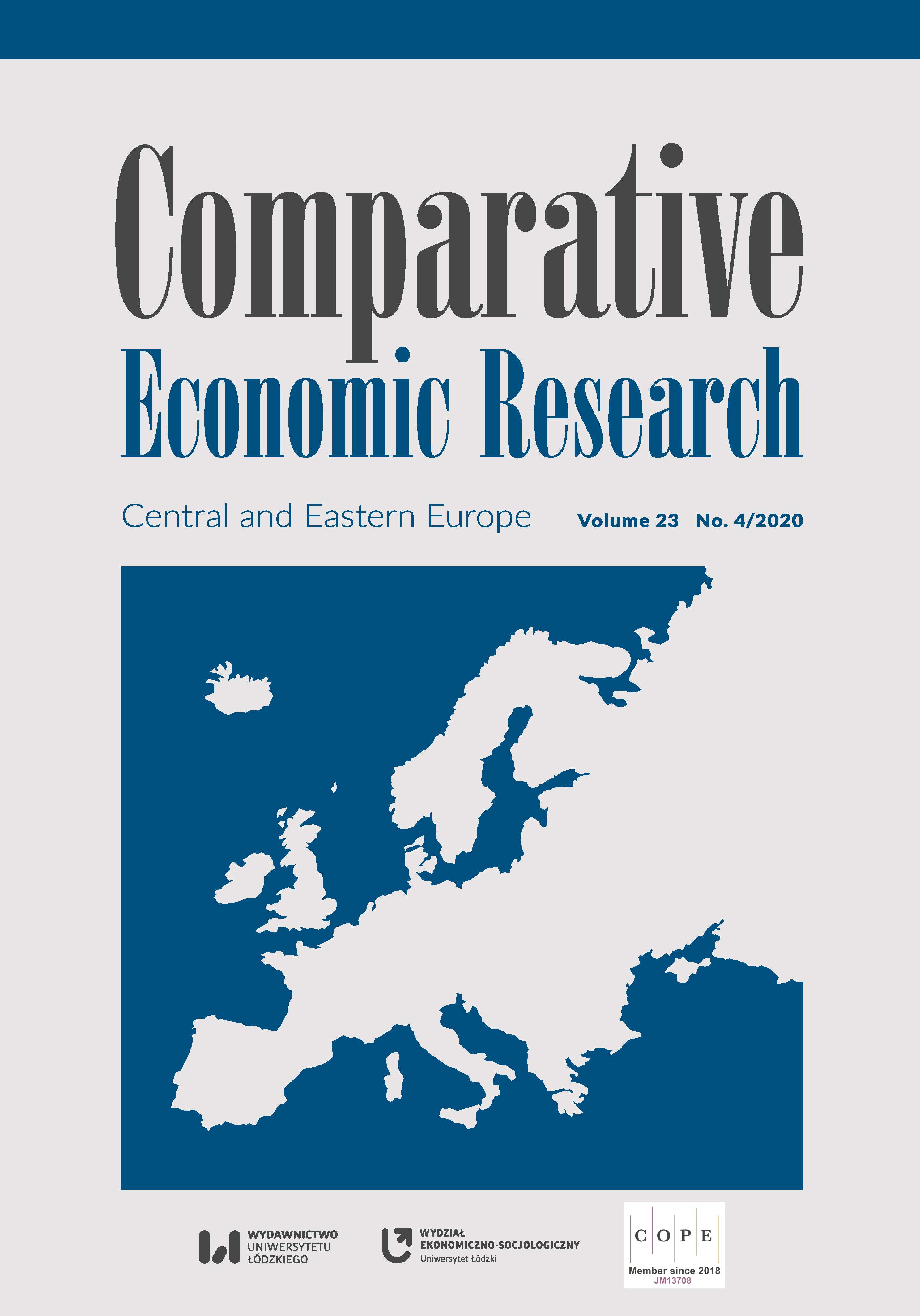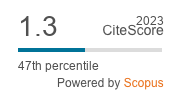An Empirical Study of the Effects of Demographic Factors on Economic Growth in Advanced and Developing Countries
DOI:
https://doi.org/10.18778/1508-2008.23.27Keywords:
population, human capital, demographic sustainability, institutional framework, economic growthAbstract
In this article, an updated approach to investigate the effects of demographic factors on economic growth is proposed. The initial hypothesis was that these factors significantly affected production proportions, determining development vectors. The predictable shifts in production dynamics are considered for the institutional framework. The article investigates the statistically significant relationships between the demographic variables and economic growth for the sample of the OECD countries (excluding Columbia) and Armenia, Belarus, Bulgaria, Croatia, Georgia, Kazakhstan, Romania, the Russian Federation, and Ukraine, from 1990 to 2017; unbalanced panel data was used. The investigation aimed to highlight the intrinsic interconnection between the changes in demographic variables (e.g., the working‑age population growth rate and the average life expectancy growth rate) and economic growth. Our investigation focused on the issue of whether demographic influence on economics was the same for advanced and developing countries in the sample. Over the period, a significant increase in life expectancy adversely affected the real GDP per capita growth rate. However, the empirical study pointed out that life expectancy was strongly linked to nominal GDP per capita. In advanced countries, the demographic indicator was considerably higher than in emerging markets. We found that the rise in the working‑age stratum of the nation’s population radically reduced the output dynamics as well, but that interconnection was not robust. The institutional framework should be taken into account in order to achieve a favorable performance of public governance in the long‑run. The main demographic variables should be properly forecasted and calibrated for potential endogenous economic triggers. Both public and private investments are important when considering the economic growth rates that are achieved. We propose a balanced approach to macroeconomic policy regarding both demographic and institutional determinants.
Downloads
References
Acemoglu, D., Johnson, S. (2007), Disease and development: the effect of life expectancy on economic growth, “Journal of Political Economy”, 115 (6), pp. 925–985. https://doi.org/10.1086/529000
Google Scholar
DOI: https://doi.org/10.1086/529000
Acemoglu, D., Restrepo, P. (2017), Secular stagnation? The effect of aging on economic growth in the age of automation, “American Economic Review”, 107 (5), pp. 174–179. https://doi.org/10.1257/aer.p20171101
Google Scholar
DOI: https://doi.org/10.1257/aer.p20171101
Ahmad, M., Khan, R.E.A. (2019), Does demographic transition with human capital dynamics matter for economic growth? A Dynamic Panel Data Approach to GMM, “Social Indicators Research”, 142 (2), pp. 753–772. https://doi.org/10.1007/s11205-018-1928 x
Google Scholar
DOI: https://doi.org/10.1007/s11205-018-1928-x
Ahsan, H., Haque, M.E. (2017), Threshold effects of human capital: Schooling and economic growth, “Economics Letters”, 156, pp. 48–52. https://doi.org/10.1016/j.econlet.2017.04.014
Google Scholar
DOI: https://doi.org/10.1016/j.econlet.2017.04.014
Barro, R.J., Lee, J.W. (2013), A new data set of educational attainment in the world, 1950–2010, “Journal of Development Economics”, 104, pp. 184–198. https://doi.org/10.1016/j.jdeveco.2012.10.001
Google Scholar
DOI: https://doi.org/10.1016/j.jdeveco.2012.10.001
Barro, R.J., Sala i Martin, X. (2003), Economic growth, 2nd ed., MIT Press, Massachusetts, https://mitpress.mit.edu/books/economic-growth-second-edition (accessed: 21.11.2019).
Google Scholar
Bloom, D.E., Canning, D., Sevilla, J. (2001), Economic growth and the demographic transition, NBER Working Paper Series 8685, National Bureau of Economic Research, Cambridge, USA. https://doi.org/10.3386/w8685
Google Scholar
DOI: https://doi.org/10.3386/w8685
Bloom, D.E., Canning, D., Sevilla, J. (2003), The demographic dividend: A new perspective on the economic consequences of population change, Rand Corporation, Santa Monica, Canada. https://www.rand.org/pubs/monograph_reports/MR1274.html
Google Scholar
DOI: https://doi.org/10.7249/MR1274
Bloom, D.E., Canning, D., Fink, G., Finlay, J.E. (2007), Does age structure forecast economic growth?, “International Journal of Forecasting”, 23 (4), pp. 569–585. https://doi.org/10.1016/j.ijforecast.2007.07.001
Google Scholar
DOI: https://doi.org/10.1016/j.ijforecast.2007.07.001
Bloom, D.E., Canning, D., Fink, G., Finlay, J.E. (2009), Fertility, female labor force participation, and the demographic dividend, “Journal of Economic Growth”, 14 (2), pp. 79–101. https://doi.org/10.1007/s10887-009-9039-9
Google Scholar
DOI: https://doi.org/10.1007/s10887-009-9039-9
Boucekkine, R., De la Croix, D., Licandro, O. (2002), Vintage human capital, demographic trends, and endogenous growth, “Journal of Economic Theory”, 104 (2), pp. 340–375. https://doi.org/10.1006/jeth.2001.2854
Google Scholar
DOI: https://doi.org/10.1006/jeth.2001.2854
Cervellati, M., Sunde, U. (2015), The economic and demographic transition, mortality, and comparative development, “American Economic Journal: Macroeconomics”, 7 (3), pp. 189–225. https://doi.org/10.1257/mac.20130170
Google Scholar
DOI: https://doi.org/10.1257/mac.20130170
Cooley, T.F., Henriksen, E., Nusbaum, C. (2019), The Growth-Cost of Demographic Change in Europe, “Review of Economic Dynamics”, 1352, pp. 1–30. https://economicdynamics.org/meetpapers/2019/paper_1352.pdf (accessed: 1.12.2019).
Google Scholar
Cuaresma, J.C., Doppelhofer, G., Huber, F., Piribauer, P. (2018), Human capital accumulation and long-term income growth projections for European regions, “Journal of Regional Science”, 58 (1), pp. 81–99. https://doi.org/10.1111/jors.12339
Google Scholar
DOI: https://doi.org/10.1111/jors.12339
Faggian, A., Partridge, M., Malecki, E.J. (2017), Creating an environment for economic growth: creativity, entrepreneurship or human capital?, “International Journal of Urban and Regional Research”, 41 (6), pp. 997–1009. https://doi.org/10.1111/1468-2427.12555
Google Scholar
DOI: https://doi.org/10.1111/1468-2427.12555
Fernihough, A. (2017), Human capital and the quantity–quality trade-off during the demographic transition, “Journal of Economic Growth”, 22 (1), pp. 35–65. https://doi.org/10.1007/s10887-016-9138-3
Google Scholar
DOI: https://doi.org/10.1007/s10887-016-9138-3
Galor, O. (2012), The demographic transition: causes and consequences, “Cliometrica”, 6 (1), pp. 1–28. https://doi.org/10.1007/s11698-011-0062-7
Google Scholar
DOI: https://doi.org/10.1007/s11698-011-0062-7
Hansen, C.W., Lønstrup, L. (2015), The rise in life expectancy and economic growth in the 20th century, “The Economic Journal”, 125 (584), pp. 838–852. https://academic.oup.com/ej/article-abstract/125/584/838/5077886?redirectedFrom=fulltext (accessed: 1.12.2019).
Google Scholar
DOI: https://doi.org/10.1111/ecoj.12261
Hanushek, E.A. (2016), Will more higher education improve economic growth?, “Oxford Review of Economic Policy”, 32 (4), pp. 538–552. https://doi.org/10.1093/oxrep/grw025
Google Scholar
DOI: https://doi.org/10.1093/oxrep/grw025
Koziuk, V., Dluhopolskyi, O. (2018), Resource curse: The role of weak institutions and cronysectors, “Ideology and Politics Journal”, 1 (9), pp. 68–104.
Google Scholar
Kozlovskyi, S., Baidala, V., Tkachuk, O., Kozyrska, T. (2018), Management of the sustainable development of the agrarian sector of the regions of Ukraine, “Montenegrin Journal of Economics”, 14 (4), pp. 175–190. http://dx.doi.org/10.14254/1800-5845/2018.14-4.12
Google Scholar
DOI: https://doi.org/10.14254/1800-5845/2018.14-4.12
Kozlovskyi, S., Grynyuk, R., Baidala, V., Burdiak, V., Bakun, Y. (2019), Economic Security Management of Ukraine in Conditions of European Integration, “Montenegrin Journal of Economics”, 15 (3), pp. 137–153. http://dx.doi.org/10.14254/1800-5845/2019.15-3.10
Google Scholar
DOI: https://doi.org/10.14254/1800-5845/2019.15-3.10
Kozlovskyi, S., Bilenko, D., Kuzheliev, M., Lavrov, R., Kozlovskyi, V., Mazur, H., Taranych, A. (2020), The system dynamic model of the labor migrant policy in economic growth affected by COVID–19, “Global Journal of Environmental Science and Management”, 6, Special Issue (Covid–19), pp. 95–106. http://dx.doi.org/10.22034/GJESM.2019.06.SI.09
Google Scholar
Lee, R.D. (2001), Demographic change and fiscal policy, Cambridge University Press, Cambridge.
Google Scholar
Lee, R.D. (2003), The demographic transition: three centuries of fundamental change, “Journal of Economic Perspectives”, 17 (4), pp. 167–190. https://doi.org/10.1257/089533003772034943
Google Scholar
DOI: https://doi.org/10.1257/089533003772034943
Lucas Jr., R.E. (2015), Human capital and growth, “American Economic Review”, 105 (5), pp. 85–88. https://doi.org/10.1257/aer.p20151065
Google Scholar
DOI: https://doi.org/10.1257/aer.p20151065
Malmberg, B. (1994), Age structure effects on economic growth – Swedish evidence, “Scandinavian Economic History Review”, 42 (3), pp. 279–295. https://doi.org/10.1080/03585522.1994.10415889
Google Scholar
DOI: https://doi.org/10.1080/03585522.1994.10415889
McGrath, P. (2016), The Relationship between Human Capital and Economic Growth in Ireland. http://dx.doi.org/10.2139/ssrn.2872739
Google Scholar
DOI: https://doi.org/10.2139/ssrn.2872739
Nagarajan, N.R., Teixeira, A.A. Silva, S.T. (2016), The impact of an ageing population on economic growth: an exploratory review of the main mechanisms, “Análise Social”, 218, pp. 4–35. https://www.jstor.org/stable/43755167
Google Scholar
Pasichnyi, M. (2017), Empirical study of the fiscal policy impact on economic growth, “Problems and Perspectives in Management”, 15 (3), pp. 316–322. http://dx.doi.org/10.21511/ppm.15(3-2).2017.01
Google Scholar
DOI: https://doi.org/10.21511/ppm.15(3-2).2017.01
Pasichnyi, M., Kaneva, T., Ruban, M., Nepytaliuk, A. (2019), The impact of fiscal decentralization on economic development, “Investment Management and Financial Innovations”, 16 (3), pp. 29–39. http://dx.doi.org/10.21511/imfi.16(3).2019.04
Google Scholar
DOI: https://doi.org/10.21511/imfi.16(3).2019.04
Pelinescu, E. (2015), The impact of human capital on economic growth, “Procedia Economics and Finance”, 22, pp. 184–190. https://doi.org/10.1016/S2212-5671(15)00258-0
Google Scholar
DOI: https://doi.org/10.1016/S2212-5671(15)00258-0
Romer, P.M. (1990), Endogenous technological change, “Journal of Political Economy”, 98 (5, Part 2), pp. S71–S102. https://doi.org/10.1086/261725
Google Scholar
DOI: https://doi.org/10.1086/261725
Sanchez‑Romero, M., Lee, R.D., Prskawetz, A. (2018), Redistributive effects of different pension structures when longevity varies by socioeconomic status in a general equilibrium setting. Population Association of America, Manuscript, pp. 1–56. https://www.econstor.eu/handle/10419/203628 (accessed: 1.12.2019).
Google Scholar
Teixeira, A.A., Queirós, A.S. (2016), Economic growth, human capital and structural change: A dynamic panel data analysis, “Research Policy”, 45 (8), pp. 1636–1648. https://doi.org/10.1016/j.respol.2016.04.006
Google Scholar
DOI: https://doi.org/10.1016/j.respol.2016.04.006
The European Commission Database (2019), https://ec.europa.eu/eurostat/data/database (accessed: 21.11.2019).
Google Scholar
The International Monetary Fund Database (2019), https://www.imf.org/en/Data (accessed: 21.11.2019).
Google Scholar
The OECD Data (2019), https://stats.oecd.org/ (accessed: 21.11.2019).
Google Scholar
The World Bank Open Data (2019), https://data.worldbank.org/ (accessed: 21.11.2019).
Google Scholar
Uddin, G.A., Alam, K., Gow, J. (2016), Population age structure and savings rate impacts on economic growth: Evidence from Australia, “Economic Analysis and Policy”, 52, pp. 23–33. https://doi.org/10.1016/j.eap.2016.08.002
Google Scholar
DOI: https://doi.org/10.1016/j.eap.2016.08.002
Downloads
Published
How to Cite
Issue
Section
License

This work is licensed under a Creative Commons Attribution-NonCommercial-NoDerivatives 4.0 International License.











